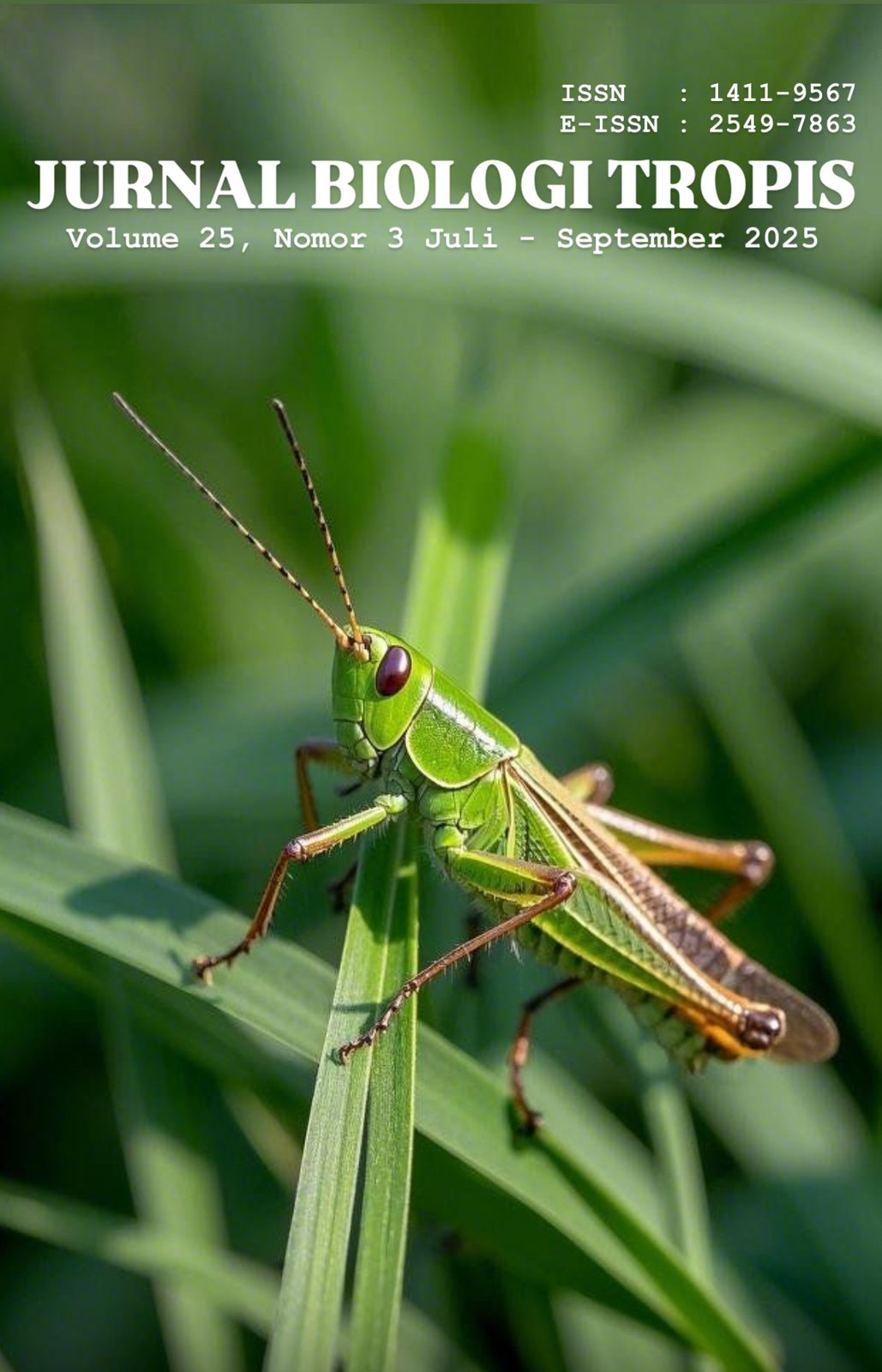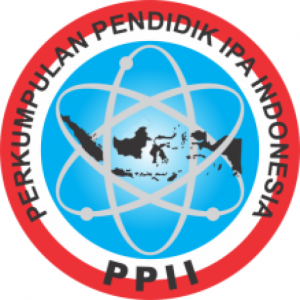Efficacy of Beauveria bassiana as a Biological Control Agent Against the Brown Planthopper Nilaparvata lugens in Rice Cultivation
Authors
Muslimin Sepe , Helda Orbani Rosa , Suhardi SuhardiDOI:
10.29303/jbt.v25i3.9094Published:
2025-07-09Issue:
Vol. 25 No. 3 (2025): Juli-SeptemberKeywords:
Beauveria bassiana, biological control, mortality, LT₅₀, greenhouse, Nilaparvata lugens.Articles
Downloads
How to Cite
Downloads
Metrics
Abstract
The brown planthopper (Nilaparvata lugens) is a major pest in rice cultivation. Its population can be effectively managed through biological control using the entomopathogenic fungus Beauveria bassiana. This study aimed to evaluate the effectiveness of the entomopathogenic fungus B. bassiana in controlling N. lugens under greenhouse conditions. Applications of B. bassiana at various concentrations revealed that 10⁸ conidia/mL treatment was the most effective, achieving up to 90% mortality within 7 days post-application. This treatment also recorded the lowest LT₅₀ value of 6.736 days and the highest regression value of 0.52, indicating a rapid and effective reduction in pest population. The mortality rate exhibited an increasing trend up to day five, followed by a decline as target population diminished, with cumulative mortality reaching 90% by day seven. These findings demonstrate that a concentration of 10⁸ conidia/mL is the most optimal for biological control of N. lugens using B. bassiana, both in terms of mortality rate and speed of action. The results support the potential of B. bassiana as a promising biological control agent in sustainable pest management strategies for agricultural systems.
References
Aprillya, M. R., Suryani, E. & Dzulkarnain, A. (2019). The analysis of quality of paddy harvest yield to support food security: a system thinking approach (case study: East Java). Procedia Computer Science. 161, 919–926. DOI: 10.1016/j.procs.2019.11.200.
Barchia, M. F., Ishak, A., Utama, S. P., & Novanda, R. R. (2021). Sustainability status of paddy cultivation on marginal peat soils in Indonesia. Bulgarian Journal of Agricultural Science, 27(2). https://www.agrojournal.org/27/02-04.pdf.
Gargita, I. W. D., Sudiarta, I. P., & Wirya, G. N. A. S. (2017). Pemanfaatan patogen serangga (Beauveria bassiana Bals.) untuk mengendalikan hama penghisap buah kakao (Helopeltis spp.) di Desa Gadungan, Kecamatan Selemadeg Timur, Kabupaten Tabanan. Jurnal Nasional, 1(1), 11-20. https://jurnal.harianregional.com/jat/full-26472.
Ihsan, A. K., Afifah, L., & Kurniati, A. (2023). Virulensi cendawan entomopatogen Beauveria bassiana terhadap wereng batang coklat Nilaparvata lugens Stal. Jurnal Agrotech, 13(1), 63-70. DOI: https://doi.org/10.31970/agrotech.v13i1.136
Irwan. (2016). Potensi bioinsektisida formulasi cair berbahan aktif Beauveria bassiana (Bals.) Vuill dan MetarhiziumSp. untuk mengendalikan wereng coklat pada tanaman padi. Jurnal Sains dan Teknologi, 5(3):25–30. @inproceedings. https://api.semanticscholar.org/CorpusID:88959595,
Iswanto EH, Susanto U, Jamil A. 2015. Perkembangan dan tantangan perakitan varietas tahan dalam pengendalian wereng coklat di Indonesia. Jurnal Penelitian dan Pengembangan Pertanian. 34:187–193. DOI: https://doi.org/10.21082/jp3. v34n4.2015.p187-193.
Jaya, A., Inoue, T., Limin, S.H., Darung, U. & Banuwa, I. S. (2010). Microclimate of developed peatland of the mega rice project in Central Kalimantan. Journal of Tropical Soils, 15(1), 63–71. DOI: https://doi.org/10.5400/jts.2010.v15i1.63-71.
Khasanah, N. (2008). Pengendalian hama penggerek tongkol jagung Helicoverpa armigera Hubner (Lepidoptera: Noctuidae) dengan Beauveria Bassiana strain lokal pada pertanaman jagung manis di Kabupaten Donggala. Jurnal Agroland, 15(2), 106-111. https://download.garuda.kemdikbud.go.id/article.php?article.
Kuswoyo A. 2022. Pengendalian Hayati Wereng Batang Cokelat Menggunakan Bakteri Kitinolitik Asal Kantong Semar pada Tanaman Padi. Thesis. Bogor: IPB University.
Maftu’ah, E. & Nursyamsi, D. (2019). Effect of biochar on peat soil fertility and NPK uptake by corn. Agrivita, 41(1), 64–73. DOI: 10.17503/agrivita.v41i1.854.
Muslimin S, M. S. (2021). Kajian “Mode of Action” Beauveria bassiana (Bals.) Vuill.(Deuteromycota: Hypomycetes) Terhadap Tribolium castaneum Herbst (Coleoptera: Tenebrionidae) (Doctoral dissertation, Universitas Hasanuddin).
Ompusunggu, D. S., Purwanto, B. H., Wulandari, C. & Utami, S. N. H. (2020). Effect of salted fish waste and cow manure on NPK availability and uptake of lowland rice on peat soil in Pelalawan Riau. Ilmu Pertanian (Agricultural Science), 5(1), 11–18. https://doi.org/10.22146/ipas.47281.
Permadi, M. A., Lubis, R. A., & Siregar, L. A. (2018). Virulensi beberapa isolat cendawan entomopatogen terhadap nimfa kepik hijau Nezara viridula Linn.(Hemiptera: Pentatomidae). Jurnal Agrohita: Jurnal Agroteknologi Fakultas Pertanian Universitas Muhammadiyah Tapanuli Selatan, 2(2), 52-60. DOI: http://dx.doi.org/10.31604/jap.v2i2.518.
Rieley, J. O., Wust, R. A. J., Jauhiainen, J., Page, S. E., Wosten, H., Hooijer, A., Siegert, F., Limin, S. H., Vasander, H. & Stahlhut, M. (2008). Tropical peatlands: carbon stores, carbon gas emissions and contribution to climate change processes, in: Strack, M. (ed.), Peatlands and climate change. International Peat Society, 148–181. https://edepot.wur.nl/41970.
Sepe, M., Daud, I. D., & Gassa, A. (2020). Infectivity of Beauveria bassiana (Balsamo) against Tribolium castaneum (Coleoptera: Tenebrionidae). Journal of Applied Research in Plant Sciences, 1(2), 53-58. DOI: https://doi.org/10.38211/joarps.2020.1.2.8.
Sepe, M., Daud, I. D., & Gassa, A. (2021, July). Production of the chitinase by Beauveria bassiana in infecting Tribolium castaneum. In IOP Conference Series: Earth and Environmental Science (Vol. 807, No. 2, p. 022101). IOP Publishing. doi:10.1088/1755-1315/807/2/022101.
Septiyana, Sutandi, A. & Indriyati, L.T. (2017). Effectivity of soil amelioration on peat soil and rice productivity. Journal of Tropical Soils, 22(1), 11–20. DOI: http://dx.doi.org/10.5400/jts.2017.v22i1.11-20.
Sianipar MS, Purnama A, Santosa E, Soesilohadi RH, Natawigena WD, Susniahti N, Primasongko A. 2017. Populasi hama wereng batang coklat (Nilaparvata lugens stal.), keragaman musuh alami predator serta parasitoidnya pada lahan sawah di dataran rendah Kabupaten Indramayu. Agrologia. 6:44–53. DOI: https://doi. org/10.30598/a.v6i1.245.
Sodiq, M., & Martiningsia, D. (2009). Pengaruh Beauveria bassiana terhadap mortalitas semut rangrang Oecophylla smaragdina (F.) (Hymenoptera: Formicidae). Jurnal Entomologi Indonesia, 6(2), 53-53.). DOI: https://doi.org/10.5994/jei.6.2.53.
Sofyan, D. A., Koesmaryono, Y., & Hidayati, R. (2019). Analisis pengaruh faktor cuaca terhadap dinamika populasi wereng batang coklat (Nilaparvata lugens Stål) yang tertangkap lampu perangkap. Indonesian Journal of Entomology, 16(1), 455247. DOI: https://doi.org/10.5994/jei.16.1.1.
Surahman, A., Soni, P. & Shivakoti, G. P. (2018). Are peatland farming systems sustainable? case study on assessing existing farming systems in the peatland of Central Kalimantan, Indonesia. Journal of Integrative Environmental Sciences, 15(01), 1–19. DOI: 10.1080/1943815X.2017.1412326.
Triwidodo, H., Istiaji, B., Efriani, N. F., Retnowati, L., & Amanatillah, N. E. (2023). Rapid assessments of the rice brown planthopper (Nilaparvata lugens Stal) outbreak in Semarang District, Central Java: Effects of farmers' low KAP: Belajar dari kajian cepat ledakan wereng coklat (Nilaparvata lugens Stal) di Kabupaten Semarang, Jawa Tengah: Pengaruh dari rendahnya PST petani. Jurnal Entomologi Indonesia, 20(2), 173-173. DOI: 10.5994/jei.20.2.137.
Wahjono, T. E., Yuliani, Y. and Hadiyanto (2024). Beauveria Bassiana; Insect Pathogen And Biopesticide Producer As An Effective And Environmentally Friendly Alternative For Biological Control. Jurnal Ilmiah Agrineca, 24(1), 97-112. DOI: https://doi.org/10.36728/afp.v24i1.2885.
License
Copyright (c) 2025 Muslimin Sepe; Helda Orbani Rosa, Suhardi Suhardi

This work is licensed under a Creative Commons Attribution 4.0 International License.

Jurnal Biologi Tropis is licensed under a Creative Commons Attribution 4.0 International License.
The copyright of the received article shall be assigned to the author as the owner of the paper. The intended copyright includes the right to publish the article in various forms (including reprints). The journal maintains the publishing rights to the published articles.
Authors are permitted to disseminate published articles by sharing the link/DOI of the article at the journal. Authors are allowed to use their articles for any legal purposes deemed necessary without written permission from the journal with an acknowledgment of initial publication to this journal.


























